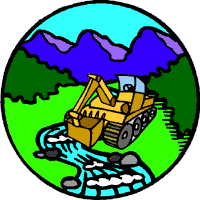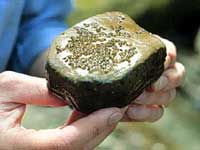
 Water
Pollution: Dredging
Water
Pollution: Dredging
Dredging
is a non-point-source pollutant. It is the process by which large rocks
are removed from a waterway. This process changes a waterway's substrate
composition as well as its shape. Dredging can turn a shallow, winding
stream with many sizes of rocks on its bottom into a deep, straight stream
with only small rocks on its bottom. In the past, rocks were often dredged
from streams to provide fill material for road- and railroad-building
activities. More recently, streams have been dredged as a means of flood
protection. Some landowners even dredge streams to create more convenient
or prettier channels. Image © 1999 -www.arttoday.com
Removal of large rocks
from a stream can decrease the stream's resistance to flow. This results
in an increase in the stream's velocity.
Increased velocity can cause downstream flooding. In addition, the removal
of large rocks often leaves a stream bed with small, uniform-size rocks.
This destroys important habitats of aquatic plants, fish,
 amphibians,
and aquatic insects. Many of these organisms
require areas with large rocks for cover,
oxygenated water, feeding, and even for
the placement of eggs (see photo below). Photo:
Larvae on a rock from Wheeling Creek. Photo courtesy of Dr. Kenneth Rastall.
amphibians,
and aquatic insects. Many of these organisms
require areas with large rocks for cover,
oxygenated water, feeding, and even for
the placement of eggs (see photo below). Photo:
Larvae on a rock from Wheeling Creek. Photo courtesy of Dr. Kenneth Rastall.
Dredging is generally performed with large machinery. Large machines in small streams disrupt the stream bed and cause a short-term siltation event. The siltation event can be harmful to downstream aquatic communities. Siltation is observed as increased turbidity . Increased turbidity can lead to increased water temperature.
Overview
..|.. Acid
Mine Drainage ..|..
Agriculture
..|.. Sewage
..|.. Dredging Home
..|..
Teacher Pages
..|..
Modules
& Activities
Glossary .|.
Related Links
.|..
References
..|..
PBL Model
.|
HTML code by Chris Kreger
Maintained by ETE Team
Last updated November 10, 2004
Some images © 2004 www.clipart.com
Privacy Statement and Copyright © 1997-2004 by Wheeling Jesuit University/NASA-supported Classroom of the Future. All rights reserved.
Center for Educational Technologies, Circuit Board/Apple graphic logo, and COTF Classroom of the Future logo are registered trademarks of Wheeling Jesuit University.